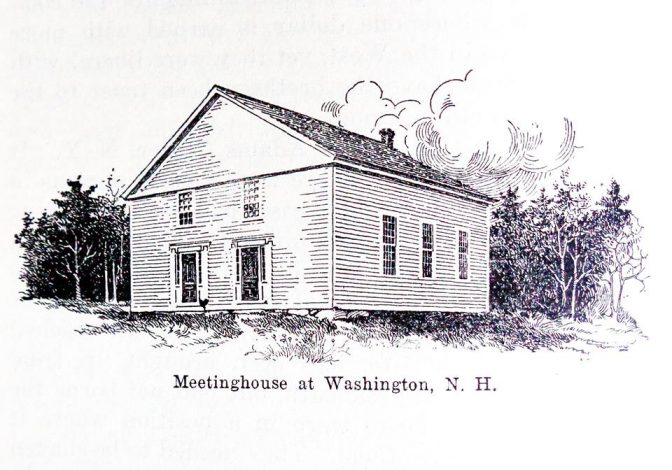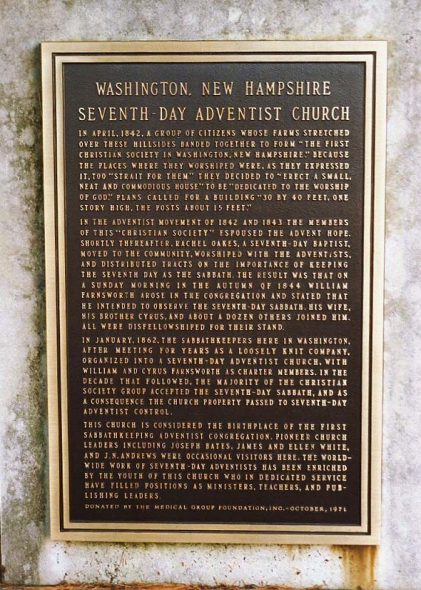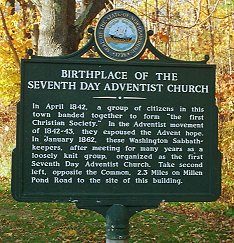History

Etching is from "Life Sketches of Ellen G. White, 1943
From the Seventh-day Adventist Encyclopedia, Volume 10, page 1575, 1976. Review and Herald Publishing Association. Used with permission.
WASHINGTON, NEW HAMPSHIRE, CHURCH. In the township of Washington, about three miles from the village of Washington Center, stands a rural church building, a white wooden structure (for description, see Church Buildings), that is often referred to as "the first SDA church."
More precisely, it is the church in which originated the first group of Sabbatarian Adventists. In 1844, apparently, in this church of the Christian Brethren, a traveling Methodist minister and a number of the lay members, who were already Adventists (Millerites), began to keep the seventh day and thus became, in that limited sense, Seventh-day Adventists.
In 1851 and on they were visited by the Whites and others. In 1862 they became an organized SDA church, but only later acquired possession, and eventually ownership, of the church building.
The Washington, New Hampshire, church was not the first organized SDA church, nor was the building the first SDA house of worship; for by 1862 there were other SDA churches already fully organized, and as early as the autumn of 1855 there was an SDA church building in Buck's Brdge, New York, and one other built or under construction in Battle Creek, Michigan (Review and Herald, 61:60 footnote, Jan. 22, 1884; 78:765, Nov. 26, 1901).
However, the Washington church may be considered the birthplace of the first Sabbath keeping Adventist congregation. James White described it as "the place where Sabbath keeping was first practiced among Adventists" (ibid., 31:104, Jan. 28, 1868).
Accounts are contradictory as to the number of the Sabbath keepers and the time when they began to observe the day, though the principal facts are clear. For the differing views on these points, see A. W. Spalding, Origin and History of Seventh-day Adventists, volume 1, pages 397-400, on which are notes to pages 115-121. These notes summarize the principal sources on the Washington church, apparently derived largely from the research of D. E. Kobinson. See also L. E. Froom, Prophetic Faith of Our Fathers, volume 4, pages 945-953.
From the Seventh-day Adventist Encyclopedia, Volume 10, page 295, 1976. Review and Herald Publishing Association. Used with permission.
CHURCH BUILDINGS
Throughout their history SDA's have erected various types of church buildings. The first church in which a group of Adventists became Sabbathkeepers, in 1844, was one erected in 1842 or 1843 by the Christian Brethren of Washington, New Hampshire. (A group of 15 organized the SDA church there in 1862, but it was many years before the SDA's had full ownership of the building.)
This church is a simple rectangular frame building 30 by 40 feet, with clapboard exterior and a plain gable roof. There are two separate entrance doors at the front, leading into a small vestibule, from which two more doors open into the church auditorium, and a narrow stairway leads up to a small balcony. The interior walls are plastered, and there is a series of plain glass windows on two sides, one of which overlooks the church cemetery about 75 feet away. The church seats about 120.
The plaque below is set at the entrance to the Sabbath Trail and gives a brief history of the church. You can read the full text below.

In April, 1842, a group of citizens whose farms stretched over these hillsides banded together to form "The First Christian Society in Washington, New Hampshire." Because the places where they worshiped were, as they expressed it, too "straight for them" they decided to "erect a small, neat and commodious house" to be "dedicated to the worship of God." Plans called for a building "30 by 40 feet, one story high, the posts about 15 feet."
In the Adventist movement of 1842 and 1843 the members of this "Christian Society" espoused the Advent hope. Shortly thereafter, Rachel Oakes, a Seventh-day Baptist, moved to the community, worshiped with the Adventists, and distributed tracts on the importance of keeping the seventh day as the Sabbath. The result was that on a Sunday morning in the autumn of 1844 William Farnsworth arose in the congregation and stated that he intended to observe the seventh day Sabbath. His wife, his brother Cyrus, and about a dozen others joined him. All were disfellowshiped for their stand.
In January, 1862, the Sabbathkeepers here in Washington, after meeting for years as a loosely knit company, organized into a Seventh-day Adventist Church, with William and Cyrus Farnsworth as charter members. In the decade that followed, the majority of the Christian Society Group accepted the seventh day Sabbath, and as a consequence the church property passed to Seventh-day Adventist control.
This church is considered the birthplace of the first Sabbathkeeping Adventist Congregation. Pioneer church leaders including Joseph Bates, James and Ellen White, and J.N. Andrews were occasional visitors here. The worldwide work of Seventh-day Adventists has been enriched by the youth of this church who in dedicated service have filled positions as ministers, teachers, and publishing leaders.
Donated by the Medical Group Foundation, Inc., October 1971
From the sign on Route 31, 0.3 miles south of the town center.
Birthplace of the Seventh Day Adventist Church
In April 1842, a group of citizens in this town banded together to form "the first Christian Society." In the Adventist movement of 1842-43, they espoused the Advent hope. In January 1862, these Washington Sabbath-keepers, after meeting for many years as a loosely knit group, organized as the first Seventh Day Adventist Church. Take second left, opposite the Common. 2.3 Miles on Millen Pond Road to the site of this building.

